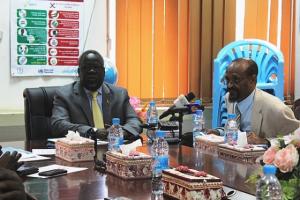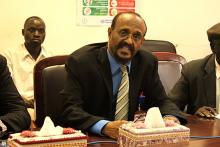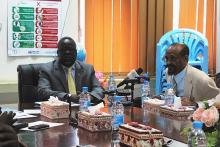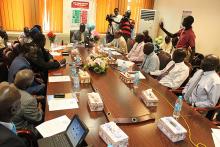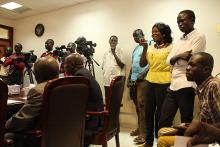South Sudan Enhances Preparedness for Ebola and Marburg
WHO in support of South Sudan’s Ministry of Health, continues to enhance efforts to prevent haemorrhagic diseases. This comes amidst fresh concerns following reports of Marburg Virus Disease in neighbouring Uganda, in addition to the Ebola Virus Disease (EVD) outbreak that is currently affecting multiple countries, mostly in West Africa.
“Although no cases of both Marburg and Ebola have been reported in South Sudan, the two outbreaks are of concern as they place the country at greater risk,” said Dr. Abdi Aden Mohamed, WHO Representative for South Sudan.
South Sudan’s history of previous outbreaks, global travel of people from affected countries and the country’s proximity to the Democratic Republic of Congo (DRC) and Uganda, which have reported Ebola and Marburg respectively, constitute risk factors for the country.
“The Ministry of Health is taking stringent measures to ensure that residents of South Sudan are safe by conducting screening of travellers arriving in the country at all international ports of entry and has set up an isolation unit at Juba Teaching Hospital,” said Dr. Riek Gai Kok, the Minister of Health in South Sudan.
Speaking at two consecutive press conferences to update the media on both Ebola and Marburg, both Dr. Mohamed and Dr. Kok outlined a raft of measures taken with support from WHO to prevent the entry and spread of the diseases into South Sudan.
A multi-sectoral Ebola Preparedness and Response Task Force has been established, with similar structures being activated at the four key border states of Central, Eastern and Western Equatoria as well as Western Bahr El Ghazal.
In light of the risk of the two diseases spreading through international travel, WHO supported the MOH to develop a protocol and the screening form for the establishment of screening activities at points of entry. The agency provided equipment for screening international arrivals at Juba International airport.More than 16,500 passengers have been screened since 23 August 2014. A needs assessment for border ports, namely Nabiapai, Nadapal, Nimule and Kaya was conducted. A phased rollout of screening at border entry points is underway with priority being given to Nimule.
Surveillance activities have been enhanced in all the states. Revised case definitions have been printed and distributed throughout the country.Surveillance officers have been trained on the diseases and the surveillance requirements starting with the high-risk states. Reporting forms for ports of entry and screening forms for international travelers have also been developed.
Training has been conducted for healthcare workers, public health and surveillance officers to enhance case detection reporting and management in high-risk states. To date training has been conducted in Yambio, Yei, Juba, Kaya, Nimule, Kapoeta, Wau, Aweil, Torit and Kuajok. So far 20 doctors, 200 nurses, 150 clinical officers, 80 public officers and 50 laboratory technicians have been trained.
To enhance case management and infection control an isolation facility has been designated and refurbished at Juba Teaching Hospital, where 46 staff have been trained and are on standby to respond in the event of cases being received.Infection control materials such as gloves and chlorine have been delivered to key hospitals. Treatment guidelines have been printed and distributed to health workers.
In order to reduce the turn-around time for results, an agreement has been reached with Uganda Virus Research Institute (UVRI) to test suspected Ebola and Marburg samples and provide results within 24 hours. So far two samples have been tested and results obtained within the stipulated timeline. Both samples tested negative for Ebola. Sample collecting and packaging materials and protocols have been disseminated to states, while laboratory focal points have been trained on how to handle samples.
Heavy duty Personal Protection Equipment (PPE) kits have been procured and prepositioned at states, key hospitals and points of entry. Tents are being procured for rapid establishment of isolation facilities in remote areas.
A communication strategy has been developed to support preparedness and outreach efforts. Messages on prevention and control have been finalized and incorporated into the varied media. Posters, factsheets, brochures, radio messages, jingles on Ebola prevention and control have been developed disseminated countrywide to enhance public awareness.
EVD is a deadly disease currently affecting Guinea, Liberia, Sierra Leone, Nigeria, Senegal, USA and most recently Spain. As of 8 October, a total of 8,399 confirmed, probable, and suspected Ebola cases and 4,033 deaths had been reported in seven affected countries, namely Guinea, Liberia, Nigeria, Senegal, Sierra Leone, Spain and the United States of America (USA). A different strain of the virus, which is unrelated to the current outbreak, was reported in DRC, which is of concern to South Sudan given the shared border between the two countries. MVD is a severe and highly fatal disease caused by a virus from the same family as the one that causes Ebola virus disease.
01 WHO Representative for South Sudan, Dr Abdi Aden Mohamed, responding to questions from journalists during a press conference
02 Minister of Health, Dr. Riek Gai Kok and WHO Representative for South Sudan, Dr Abdi Aden Mohamed addressing a joint press conference in Juba
03 A journalist asking a question during the press conference
04 Some of the journalists who attended the press conferences hosted by the Ministry of Health with support from WHO
Photo credits: WHO/M. Moyo



